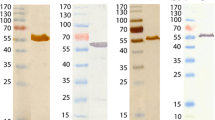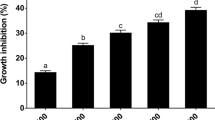Abstract
Gluconobacter oxydans is an industrially important bacterium owing to its regio- and enantio-selective incomplete oxidation of various sugars, alcohols, and polyols. The complete genome sequence is available, but it is still unknown how the organism adapts to highly osmotic sugar-rich environments. Therefore, the mechanisms of osmoprotection in G. oxydans were investigated. The accumulation and transport of solutes are hallmarks of osmoadaptation. To identify potential osmoprotectants, G. oxydans was grown on a yeast glucose medium in the presence of 100 mM potassium phosphate (pH 7.0) along with various concentrations of sucrose (0–600 mM final concentration), which was not metabolized. Intracellular metabolites were analyzed by HPLC and 13C NMR spectroscopy under stress conditions. Both of these analytical techniques highlighted the accumulation of mannitol as a potent osmoprotectant inside the stressed cells. This intracellular mannitol accumulation correlated with increased extracellular osmolarity of the medium. For further confirmation, the growth behavior of G. oxydans was analyzed in the presence of small amounts of mannitol (2.5–10 mM) and 300 mM sucrose. Growth under sucrose-induced osmotic stress conditions was almost identical to control growth when exogenous mannitol was added in low amounts. Thus, mannitol alleviates the osmotic stress of sucrose on cellular growth. Moreover, the positive effect of exogenous mannitol on the rate of glucose consumption and gluconate formation was also monitored. These results may be helpful to optimize the processes of industrial product formation in highly concentrated sugar solutions.






Similar content being viewed by others
References
Adachi O, Toyama H, Matsushita K (1999) Crystalline NADP-dependent D-mannitol dehydrogenase from Gluconobacter suboxydans. Biosci Biotechnol Biochem 63:402–407
Asai T (1971) The classification and biochemistry of acetic acid bacteria. In: Sakaguchi K, Vemuna T, Kinoshito S (eds) Biochemical and industrial aspects of fermentation. Kadansha Ltd., Tokyo, pp 201–232
Arakawa T, Timasheff SN (1985) The stabilization of proteins by osmolytes. Biophys J 47:411–414
Bligh EG, Dyer WJ (1959) A rapid method of lipid extraction and purification. Can J Biochem Physiol 37:911–917
Bradford MM (1976) Rapid and sensitive method for the quantitation of microgram quantities of protein utilizing the principle of protein-dye binding. Anal Biochem 72:248–254
Chalcoff VR, Aizeni MA, Galetto L (2006) Nectar concentration and composition of 26 species from the temperate forest of South America. Ann Bot 97:413–421
De Ley J, Gillis M, Swings J (1984) The genus Gluconobacter. In: Krieg NR, Holt JG (eds) Bergey’s manual of systematic bacteriology, vol 1. Williams and Wilkins, Baltimore, pp 267–278
De Muynck C, Pereira CSS, Naessens M, Parmentier S, Soetaert W, Vandamme EJ (2007) The genus Gluconobacter oxydans: comprehensive overview of biochemistry and biotechnological applications. Crit Rev Biotechnol 27:147–171
Deppenmeier U, Ehrenreich A (2009) Physiology of acetic acid bacteria in light of the genome sequence of Gluconobacter oxydans. J Mol Microbiol Biotechnol 16:69–80
Dragosits M, Mozhayskiy V, Quinones-Soto S, Park J, Tagkopoulos I (2013) Evolutionary potential, cross-stress behavior and the genetic basis of acquired stress resistance in Escherichia coli. Mol Syst Biol 9:643
Efiuvwevwere BJO, Gorris LGM, Smid EJ, Kets EPW (1999) Mannitol-enhanced survival of Lactococcus lactis subjected to drying. Appl Microbiol Biotechnol 51:100–104
Empadinhas N, da Costa MS (2009) Diversity, distribution and biosynthesis of compatible solutes in prokaryotes. Contrib Sci 5:95–105
Galinski EA, Herzog RM (1990) The role of trehalose as a substitute for nitrogen-containing compatible solutes. Arch Microbiol 153:607–613
Groisillier A, Labourel A, Michel G, Tonon T (2014) The mannitol utilization system of the marine bacterium Zobellia galactanivorans. Appl Environ Microbiol. doi:10.1128/AEM.02808-14, Published online ahead of print on 29 December 2014
Gupta A, Singh VK, Qazi GN, Kumar A (2001) Gluconobacter oxydans: its biotechnological applications. J Mol Microbiol Biotechnol 3:445–456
Hancock RD (2009) Recent patents on vitamin C: opportunities for crop improvement and single-step biological manufacture. Recent patents on food. Nutr Agric 1:39–49
Hanke T, Nöh K, Noack S, Polen T, Bringer S, Sahm H, Wiechert W, Bott M (2013) Combined fluxomics and transcriptomics analysis of glucose catabolism via a partially cyclic pentose phosphate pathway in Gluconobacter oxydans 621H. Appl Environ Microbiol 79:2336–2248
Iwamoto K, Shiraiwa Y (2005) Salt regulated mannitol metabolism in algae. Mar Biotechnol Mini Rev 7:407–415
Jennings DH (1984) Polyol metabolism in fungi. Adv Microb Physiol 25:149–193
Kets EPW, Galinski EA, De Witt M, De Bont JAM, Heipieper H (1996) Mannitol, a novel compatible solute in Pseudomonas putida S12. J Bacteriol 178:6665–6670
Kets EPW (1997) Compatible solutes in lactic acid bacteria subjected to water stress. Ph.D. Thesis, Wageningen Agricultural University, Wageningen, The Netherlands
Koch AL (1997) Microbial physiology and ecology of slow growth. Microbiol Mol Biol Rev 61:305–318
Lee SY (1996) High cell density culture of Escherichia coli. Trends Biotechnol 14:98–105
Lewis IA, Schommer SC, Markley JL (2009) rNMR: open source software for identifying and quantifying metabolites in NMR spectra. Magn Reson Chem 47:123–126
Loos H, Krämer RH, Sprenger GA (1994) Sorbitol promotes growth of Zymomonas mobilis in environments with high concentrations of sugar: evidence for a physiological function of glucose-fructose oxidoreductase in osmoprotection. J Bacteriol 176:7688–7693
Luchterhand B, Fischöder T, Grimm AR, Wewetzer S, Wunderlich M, Schlepütz T, Büchs J (2015) Quantifying the sensitivity of G. oxydans ATCC 621H and DSM 3504 to osmotic stress triggered by soluble buffers. J Ind Microbiol Biotechnol 42:585–600
Mattey M (1992) The production of organic acids. Crit Rev Biotechnol 12:87–132
Meyer M, Schweiger P, Deppenmeier U (2013) Effects of membrane-bound glucose dehydrogenase overproduction on the respiratory chain of Gluconobacter oxydans. Appl Microbiol Biotechnol 97:3457–3466
Oren A (1999) Bioenergetic aspects of halophilism. Microbiol Mol Biol Rev 63:334–348
Ortiz ME, Bleckwedel J, Raya RR, Mozzi F (2013) Biotechnological and in situ food production of polyols by lactic acid bacteria. Appl Microbiol Biotechnol 97:4713–4726
Prescott FJ, Shaw JK, Bilello P, Cragwall GO (1953) Gluconic acid and its derivatives. Ind Eng Chem 45:338–342
Pronk JT, Levering PR, Olijve W, Van Dijken JP (1989) Role of NADP dependent and quinoprotein glucose dehydrogenase in gluconic acid production by Gluconobacter oxydans. Enzym Microb Technol 11:160–164
Prust C, Hoffmeister M, Liesegang H, Wiezer A, Fricke WF, Ehrenreich A, Gottschalk G, Deppenmeier U (2005) Complete genome sequence of the acetic acid bacterium Gluconobacter oxydans. Nat Biotechnol 23:195–200
Rabenhorst J, Gatfield I, Hilmer JM (2001) Natural, aliphatic and thiocar-boxylic acids obtainable by fermentation and a microorganism therefore. Patent EP1078990
Rauch B, Pahlke J, Schweiger P, Deppenmeier U (2010) Characterization of enzymes involved in glucose and gluconate utilization in the central metabolism of Gluconobacter oxydans. Appl Microbiol Biotechnol 88:711–718
Richhardt J, Bringer S, Bott M (2012) Mutational analysis of the pentose phosphate and Entner-Doudoroff pathways in Gluconobacter oxydans reveals improved growth of a Δedd Δeda mutant on mannitol. Appl Environ Microbiol 78:6975–6986
Riesenberg D, Schulz V, Knorre WA, Pohl HD, Korz D, Sanders EA, Ross A, Deckwer WD (1991) High cell density cultivation of E. coli at controlled specific growth rate. J Biotechnol 20:17–28
Romantsov T, Stalker L, Culham DE, Wood JM (2008) Cardiolipin controls the osmotic stress response and the subcellular location of transporter ProP in Escherichia coli. J Biol Chem 283:12314–12323
Saha BC, Racine FM (2011) Biotechnological production of mannitol and its applications. Appl Microbiol Biotechnol 89:879–891
Sand M, Mingote AI, Santos H, Müller V, Averhoff B (2013) Mannitol, a compatible solute synthesized by Acinetobacter baylyi in a two-step mechanism including a salt-induced and salt-dependent mannitol-1-phosphate dehydrogenase. Environ Microbiol 15:2187–2197
Sawyer DT (1964) Metal-gluconate complexes. Chem Rev 64:633–643
Schedel M (2000) Regioselective oxidation of aminosorbitol with Gluconobacter oxydans, key reaction in the industrial 1-deoxynojirimycin synthesis. In: Kelly DR (ed) Biotechnology, vol 8b. Wiley-VCH, Weinheim, pp 295–308
Sévin DC, Sauer U (2014) Ubiquinone accumulation improves osmotic-stress tolerance in Escherichia coli. Nat Chem Biol 10:266–272
Shiloach J, Fass R (2005) Growing E. coli to high cell density: a historical perspective on method development. Biotechnol Adv 23:345–357
Sievers M, Swings J (2005) Family II Acetobacteriaceae. In: Garrity G, Brenner DJ, Krieg NR, Staley JT (eds) Bergey’s manual of systematic bacteriology, vol 2c. Springer, New York, pp 41–95
Sootsuwan K, Thanonkeo P, Keeratirakha N, Thanonkeo S, Jaisil P, Yamada M (2013) Sorbitol required for cell growth and ethanol production by Zymomonas mobilis under heat, ethanol, and osmotic stresses. Biotechnol Biofuels 6:180–193
Wiegmann K, Hensler M, Wöhlbrand L, Ulbrich M, Schomburg D, Rabus R (2014) Carbohydrate catabolism in Phaeobacter inhibens DSM 17395, a member of the marine roseobacter clade. Appl Environ Microbiol 80:4725–4737
Winkler JD, Garcia C, Olson M, Callaway E, Kao KC (2014) Evolved osmotolerant Escherichia coli mutants frequently exhibit defective N-acetylglucosamine catabolism and point mutations in cell shape-regulating protein MreB. Appl Environ Microbiol 80:3729–3740
Wisselink HW, Weusthuis RA, Eggink G, Hugenholtz J, Grobben GJ (2002) Mannitol production by lactic acid bacteria: a review. Int Dairy J 12:151–161
Acknowledgments
We thank Dr. Fabian Grein from the Institute of Microbiology and Biotechnology, University of Bonn, for assisting in microscopic examination of cell cultures. Special thanks to the Higher Education Commission of Pakistan and their German collaborators DAAD for financial support (scholarship for NZ). We thank Elisabeth Schwab and Marlene Hecker for technical assistance.
Conflict of interest
There is no conflict of interest for all authors.
Author information
Authors and Affiliations
Corresponding author
Electronic supplementary material
Below is the link to the electronic supplementary material.
ESM 1
(PDF 158 kb)
Rights and permissions
About this article
Cite this article
Zahid, N., Schweiger, P., Galinski, E. et al. Identification of mannitol as compatible solute in Gluconobacter oxydans . Appl Microbiol Biotechnol 99, 5511–5521 (2015). https://doi.org/10.1007/s00253-015-6626-x
Received:
Revised:
Accepted:
Published:
Issue Date:
DOI: https://doi.org/10.1007/s00253-015-6626-x




